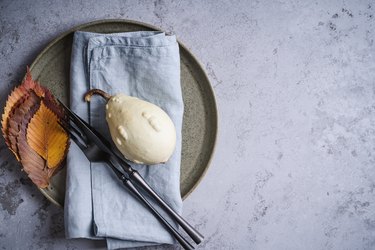
Properly setting the table for a meal, whether it's a formal six-course dinner or a casual supper with the kids, not only displays your style and grace, but also helps everyone know which utensils belong to them. While there are some similarities between informal and formal table settings, there are also some marked differences. Which one you choose depends on how you're serving the meal.
Major Differences Between Informal and Formal Table Settings
Video of the Day
The primary difference between formal and informal place settings is the number of items placed on the table. A formal table setting, designed for a meal served in multiple courses, includes utensils for each course, plus a separate plate for the bread and butter. A formal table setting may also include multiple glasses for champagne, wine and water, plus a sherry or dessert wine glass.
Video of the Day
A casual table setting, in contrast, assumes that the entire meal is served on one plate with one set of utensils. The setting includes one fork, knife and spoon, and one glass for the drink served during the meal.
Dinner Plates for Table Settings
A formal table setting is arranged so that food can be served on pre-arranged plates while a casual table setting can accommodate either pre-arranged plates or food served family style at the table, with each diner filling his own plate. A formal setting often includes a charger, or a decorative plate that serves as a base for the salad and soup courses. Servers remove the charger before bringing the main course.
In contrast, in a casual setting, the dinner plate is set on the table before the meal, without a charger. If the main dish has a sauce, you can place a separate salad plate to the left of the forks, but otherwise salad is served on the dinner plate.
Dessert Table Settings
Another difference between informal and formal table settings is the placement of dessert utensils and coffee cups. In a very formal environment, the utensils for dessert are brought to the table during the dessert course, along with the coffee cup and saucer.
In an informal setting, the dessert spoon or fork is set horizontally above the plate -- fork handles face left, spoon handles face right – or next to the plate on the appropriate side. In an informal setting, you can set the coffee cup and saucer to the right of the knives and spoons or bring the cups to the table at the end of the meal. For very casual, everyday meals at home, bring the dessert utensils and coffee to the table, after the meal, if you're having dessert.
General Place Setting Rules
Regardless of whether you're setting a formal or informal table, the basic placement of the dishes and utensils is the same. The forks always go to the left of the plate; the knives and spoons are always to the right. Arrange the utensils in the order of use from the outside in. Place napkins to the left of the fork or on top of the plate.
Glassware goes on the right of the plate above the knives, and the bread plate goes on the left above the napkin. Knife blades should always face in toward the plate whether for an informal or formal table setting.